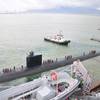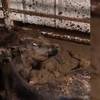Federal and Louisiana agencies settled with Marine Oil Trader 3, Ltd. and Ermis Maritime Corp. for the November 2000 T/V Westchester oil spill into the Mississippi River in Plaquemines Parish, La. With oversight from the Commerce Department’s National Oceanic and Atmospheric Administration (NOAA), U.S.
Department of the Interior’s U.S. Fish and Wildlife Service (USFWS), the Louisiana Oil Spill Coordinator’s
Office, the Louisiana Department of Wildlife and Fisheries, the Louisiana Department of Natural Resources,
and the Louisiana Department of Environmental Quality, the responsible parties will begin implementing
restoration projects to address the resources injured by the spill.
On Nov. 28, 2000, the T/V Westchester grounded in the Mississippi River at River Mile 38, discharging approximately 500,000 gallons of crude oil into the Mississippi River downstream from New Orleans in Plaquemines Parish, La. The incident resulted in injuries to fish and shellfish, birds, and lost fishing and
hunting opportunities.
While response agencies contained the oil and cleaned the area, NOAA, the USFWS, the Louisiana Oil Spill
Coordinator’s Office, the Louisiana Department of Wildlife and Fisheries, the Louisiana Department of Natural
Resources, and the Louisiana Department of Environmental Quality acted as trustees on behalf of the public
to conduct a natural resource damage assessment to identify and restore injured natural resources.
“By working cooperatively throughout the assessment, the agencies and the responsible party reached an
agreement for restoration more efficiently,” said Richard W. Spinrad, assistant administrator for the NOAA
National Ocean Service. “Working together on natural resource damage assessments benefits industry, the
affected community, and, most importantly, the environment.”
Under the terms of the settlement agreement, Marine Oil Trade 3, Ltd. and Ermis Maritime Corp., with trustee
agency oversight, will implement a marsh restoration project in the Pass-a-Loutre State Wildlife Management
Area, south of Venice, La., that will grow to an expected 20 acres in size, with potential growth to 100 acres.
The project involves making a cut (crevasse splay) in the riverbank, which will allow the natural process of
sedimentation and vegetative colonization to occur and form marsh in the Mississippi River Delta. The marsh
will provide critical nursery habitat for shrimp, fish, and other aquatic species, nesting and foraging habitat for
birds and other wildlife, and enhanced opportunities for fishing and hunting.
“Whether it was developing injury study plans or identifying restoration projects, we shared information and
made joint decisions,” explained Gary Mauseth of Polaris Applied Sciences, Inc., a representative of the
responsible parties. “With this level of cooperation, we achieved our goal more quickly–restoring the natural
resources.”
In addition to the ecological restoration project, Marine Oil Trader 3, Ltd. and Ermis Maritime Corp. will
construct a multipurpose dock to enhance hunting, fishing, and recreational opportunities at the Pass-a-Loutre
State Wildlife Management Area near the Freshwater Reservoir.
“Our goal was to compensate the citizens of the State for injuries to our natural resources. Implementing
these restoration projects will enable us to accomplish our goal,” said Roland Guidry with the Oil Spill
Coordinator’s Office.
The goal of a natural resource damage assessment is to restore the natural resources and services injured by
an oil release. Under the Oil Pollution Act of 1990, federal and state agencies determine the nature and extent
of natural resource injuries, select appropriate restoration projects, and implement or oversee restoration.
NOAA’s National Ocean Service balances environmental protection with economic prosperity in fulfilling its
mission of promoting safe navigation, supporting coastal communities, sustaining coastal habitats and
mitigating coastal hazards.
The Commerce Department’s National Oceanic and Atmospheric Administration is dedicated to enhancing
economic security and national safety through the prediction and research of weather and climate-related
events and providing environmental stewardship of our nation's coastal and marine resources.
Featured videos

Inside the Electrified Truckable Tug

Tracking Foreign Vessels Working in the U.S. Jones Act Market

Inmarsat Enhances Service to Drive Digitalization
Subscribe for
Maritime Reporter E-News
Maritime Reporter E-News is the maritime industry's largest circulation and most authoritative ENews Service, delivered to your Email five times per week









